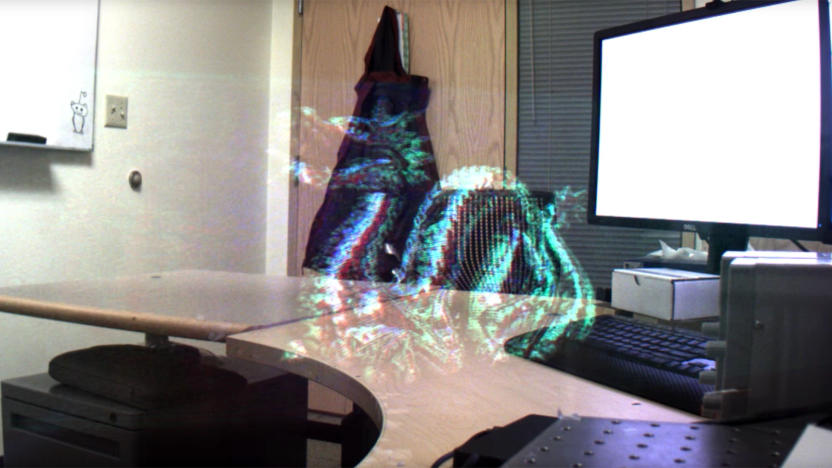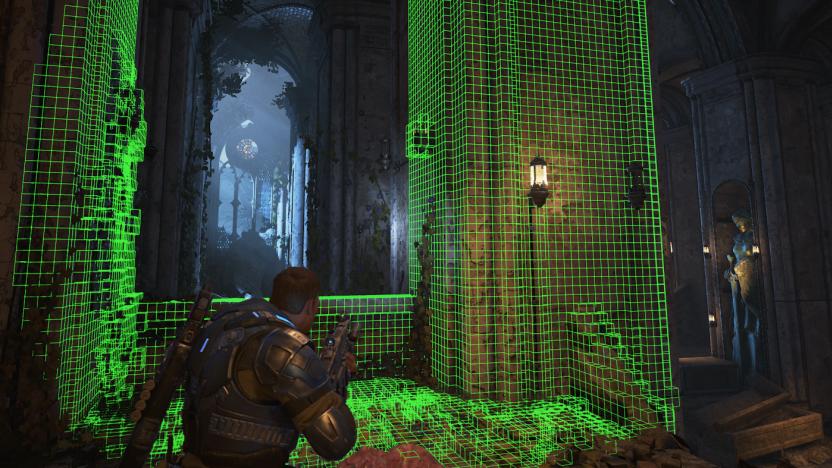MicrosoftResearch
Latest

Microsoft’s mad scientists are making AR more tactile
Unless you hate fun, Microsoft's best division is far and away its Research group, which has given us the nearest thing to a Holodeck, a live-action version of Minecraft and much more. Microsoft's gang of crazy researchers is at it again, showing off a bunch of new controllers for augmented and virtual reality. They're strictly experimental for now, but show a lot of potential for making AR and VR more fun and useful.
Steve Dent03.12.2018
Microsoft Research uses AI to help drones soar like eagles
Microsoft is looking to the skies for its next round of AI inspiration. Specifically, Redmond's Research division is using the birds that capture columns of warm air to glide around without expending much energy to guide its work. So far, it's been able to keep a 16.5 foot, 12.5 pound sailplane in the air thanks in part to algorithms that aid the craft in finding and using the thermals.
Timothy J. Seppala08.16.2017
Microsoft will offer its AI smarts to benefit the environment
Microsoft just announced a new initiative called AI for Earth. Headed by Microsoft's chief environmental scientist Lucas Joppa, the program will help researchers and organizations use AI to solve the major environmental issues we face today. Leaders of projects focusing on water, agriculture, biodiversity and climate change can apply for access to Microsoft's cloud and AI computing resources and it's putting down $2 million towards the initiative this year.
Mallory Locklear07.12.2017
Microsoft's true holographic display fits in your glasses
A lot of the technology billed as holographic, well, isn't. Not even HoloLens. Real holography requires a laser-generated 3D image, and it's no mean feat to stuff that into something you can comfortably wear. Microsoft just made some important progress, however. Its researchers have developed a true, near-eye holographic whose optics can fit inside a regular pair of glasses. The mirrors and the liquid crystal on silicon needed to achieve the effect sit inside the frame -- it's only the electronics that have to stay outside. While this extra-compact size would normally result in an unusable picture, corrections in the holographic projector make it easy to read details down to individual pixels.
Jon Fingas05.20.2017
Lightform computer brings glasses-free augmented reality 'anywhere'
We've seen some really neat results when it comes to projection mapping -- especially from this year's SXSW -- but new tech from former Microsoft and Disney employees could change the game. Lightform takes tech like IllumiRoom and what Disney Research and Razer have worked on prior and amps it up. At its core, Lightform is a camera that hooks up to "any video projector" via HDMI and works in tandem with it to display complex, interactive scenes on every day objects. Yep, even houseplants.
Timothy J. Seppala03.27.2017
Your search history could be an early detector for lung cancer
"You may have lung cancer. Please consult a physician." That'd very likely be the worst alert you could ever see on your phone, right? In the future, though, it could be a reality. By looking at anonymous search history and cross-referencing it with demographic data, scientists from Microsoft Research propose that 39 percent of oncology diagnosis could be made a year earlier -- no Watson required. It definitely sounds like something out of Minority Report, but applied to healthcare.
Timothy J. Seppala11.11.2016
Microsoft Research has two types of touch for VR haptics
Virtual reality is one of the most immersive technologies available today. That is until the illusion shatters when you instinctively reach out to touch something and are met with a one-size-fits-all haptic response or no feedback at all. Microsoft Research (PDF) might have the solution to that. Rather than air-based haptics like we've seen before, "NormalTouch" and "TextureTouch" use handheld devices to simulate touching things while in VR -- no bodysuit required.
Timothy J. Seppala10.28.2016
Microsoft Research helped 'Gears of War 4' sound so good
Popping in and out of cover has been a hallmark of the Gears of War franchise since the first game came out in 2006. It hasn't changed much because it didn't need to. What's always been an issue though is how thin the game sounds -- a shortcoming of the underlying tech, Unreal Engine, powering it. But Microsoft owns the series now and has far more money to throw at it than former owners/Unreal Engine creators Epic Games did. With help from Microsoft Research, Redmond's Gears of War factory The Coalition found a high tech way to fix that problem. It's called Triton. Two years ago Microsoft Research's Nikunj Raghuvanshi and John Snyder presented a paper (PDF) titled "Parametric Wave Field Coding for Precomputed Sound Propagation." The long and short of the research is that it detailed how to create realistic reverb effects based on objects in a video game's map, to hear it in action pop on a pair of headphones and watch the video below.
Timothy J. Seppala10.25.2016
Microsoft hopes AI will find better cancer treatments
Google isn't the only tech giant hoping that artificial intelligence can aid the fight against cancer. Microsoft has unveiled Project Hanover, an effort to use AI for both understanding and treating cancers. To begin with, the company is developing a system that would automatically process legions of biomedical papers, creating "genome-scale" databases that could predict which drug cocktails would be the most effective against a given cancer type. An ideal treatment wouldn't go unnoticed by doctors already swamped with work.
Jon Fingas09.20.2016
Microsoft's take on Pinterest has you collecting real objects
As popular as Pinterest is, it's limited: with certain exceptions, you're really just collecting internet content. What if you have something cool to show off in the real world? The Microsoft Garage team wants to help. It just launched Thinga.me, a mobile-focused service (currently iPhone-only) that has you collecting real objects. If you want to share your favorite apparel or a vintage toy collection, you just have to take photos -- Thinga.me will cut out the backgrounds and drop them into the themed gallery of your choice. Of course, you can tag and share collections to help others find what they're looking for.
Jon Fingas07.06.2016
Microsoft's hand-tracking magic may lead to gamepad-free VR
The next Xbox One S console doesn't even have a Kinect port, showing that even Microsoft doesn't care about the depth sensor for gaming. However, it may yet make a comeback in VR. Microsoft researchers have made hand- and finger-tracking much more accurate using the Kinect, which may eventually make it a more attractive option than a controller for VR games. "We're getting to the point that the accuracy is such that the user can start to feel like the avatar hand is their real hand," says Microsoft UK researcher Jamie Shotton.
Steve Dent06.28.2016
Microsoft helps you create links to your phone apps
You know the problem -- you want to go back to something you saw in a mobile app, but you either forgot to save your place or couldn't save it at all. What to do? If Microsoft Research has its way, you'll never be left scrambling again. Its uLink experiment creates links to mobile app pages on the fly, helping you find that hotel listing without having to re-do all the steps you took to see it. It's a bit like Google's deep app linking without the need to go online.
Jon Fingas06.20.2016
Microsoft Research wants to pit you against virtual swimmers
You don't need other people to swim, but a Microsoft Research project can spice up your swimming routine by putting you in or pitting you against virtual teams. Redmond's research division is working with a team of researchers from Korea Advanced Institute of Science and Technology (KAIST) to develop SwimTrain. It's a system consisting of an app, a waterproof case for your smartphone and a pair of underwater headphones that provides sensory/auditory feedback. SwimTrain puts you in a team of three swimmers -- if you're competing, it tells you how you're doing against your two virtual opponents. If you're in the same team, it helps you maintain your strokes so you can keep up with your virtual teammates.
Mariella Moon05.11.2016
Microsoft thinks disorientation is the key to touch in VR
To manipulate virtual objects in VR, you have to use an Oculus Touch or other "virtual wand" controller like some kind of hands-off, digital tong. To get an actual "haptic" or touch experience, you need real objects, but it's computationally challenging because the system needs to precisely track each one. Researchers from Microsoft, USC and the University of Waterloo have discovered that by manipulating how you see your body and the world in VR, they can make you think that a single physical object has magically multiplied.
Steve Dent05.04.2016
ICYMI: Teleport your hologram, changing ocean pH and more
#fivemin-widget-blogsmith-image-681979{display:none;} .cke_show_borders #fivemin-widget-blogsmith-image-681979, #postcontentcontainer #fivemin-widget-blogsmith-image-681979{width:570px;display:block;} try{document.getElementById("fivemin-widget-blogsmith-image-681979").style.display="none";}catch(e){}Today on In Case You Missed It: Microsoft Research developed a new 3D camera capturing system that creates a live-time 3D hologram of a person that can be sent to interact with other people, as long as they have a matching virtual reality set-up. If that's confusing, the video straightens it right up.
Kerry Davis03.29.2016
'Holoportation' demo makes live-video holograms look easy
Last June Microsoft showed off its HoloLens tech that created holograms from live video. Now it's putting that into practice and giving it an official name: Holoportation. It uses multiple 3D cameras to capture a subject from all angles, creating a "temporally consistent model" that can mimic the feeling of someone being in a room with you. During a TED Talk,Alex Kipman used it to virtually meet with a colleague in front of a Mars backdrop, but this lab demo from Microsoft Research shows something a bit more realistic. That is, so long as you're wearing one of the $3,000 augmented reality headsets.
Timothy J. Seppala03.26.2016
Game algorithm could help win elections
There's a particular strain of game theory, Colonel Blotto, that many believe could predict the outcomes of everything from elections to sports matches. It asks two sides to distribute soldiers over a battlefield, and hands wins to whoever has the most soldiers in a given area. However, it has one glaring problem: there hasn't been a way to get a firm solution. Well, computer scientists have finally found that last piece of the puzzle. They've developed an algorithm that can solve the Colonel Blotto game, making it useful as a strategic tool whenever there's a one-on-one situation.
Jon Fingas02.12.2016
Microsoft wants you to scan in 3D using only your phone
If you want to do some 3D scanning, you usually have to get either a dedicated scanner or a less-than-elegant add-on. Microsoft Research and the University of Oxford think there's a better way, though. Their MobileFusion project captures 3D models using only an app on your smartphone. The software scans objects by comparing image frames from your phone's camera and creating stereo depth maps from the results -- you just have to walk around an object to get more detail. It's much like Kinect Fusion, but you're not tied to either a PC or a clunky peripheral.
Jon Fingas08.24.2015
Microsoft wants you to teach computers how to learn
As clever as learning computers may be, they only have as much potential as their software. What if you don't have the know-how to program one of these smart systems yourself? That's where Microsoft Research thinks it can help: it's developing a machine teaching tool that will let most anyone show computers how to learn. So long as you're knowledgeable about your field, you'd just have to plug in the right parameters. A chef could tell a computer how to create tasty recipes, for example, while a doctor could get software to sift through medical records and find data relevant to a new patient.
Jon Fingas07.12.2015
Microsoft has $500K in prize money for HoloLens science projects
Microsoft wowed me a few weeks ago with its internal HoloLens programs, but like we've seen with Kinect, the coolest uses aren't always the ones Redmond devised. To help make more applications a reality, the tech giant has opened up what it's calling the Academic Research Request for Proposals. Five awards -- each including $100,000 and two HoloLens development kits -- will go to accredited universities and be announced this October 6th. The official reasoning here is that Microsoft wants to "better understand the role and possible applications for holographic computing in society." So, to see what people outside of the Redmond campus think augmented reality is capable of. Got it. Other objectives include spurring research for mixed reality and generally getting more people to make holograms. A few examples the company lays out are data visualizations (similar to Epic Games) and creating 3D models for medical training.
Timothy J. Seppala07.06.2015